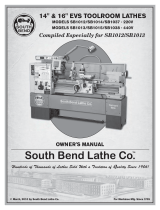Clarke Woodworker CWL-20RV Specification
- Category
- Power tools
- Type
- Specification
This manual is also suitable for
Clarke Woodworker CWL-20RV is a versatile machine with a 0.5 HP motor that provides ample power for wood turning tasks. Its 850mm max distance between centers and 304mm centre height turning capacity make it suitable for turning bowls, spindles, and other large projects. With 10 variable speeds ranging from 500 to 2000 RPM, you can choose the optimal speed for the material you're working with. The reversible headstock allows you to easily switch between clockwise and counterclockwise rotation for added versatility.
Clarke Woodworker CWL-20RV is a versatile machine with a 0.5 HP motor that provides ample power for wood turning tasks. Its 850mm max distance between centers and 304mm centre height turning capacity make it suitable for turning bowls, spindles, and other large projects. With 10 variable speeds ranging from 500 to 2000 RPM, you can choose the optimal speed for the material you're working with. The reversible headstock allows you to easily switch between clockwise and counterclockwise rotation for added versatility.










-
 1
1
-
 2
2
-
 3
3
-
 4
4
-
 5
5
-
 6
6
-
 7
7
-
 8
8
-
 9
9
-
 10
10
Clarke Woodworker CWL-20RV Specification
- Category
- Power tools
- Type
- Specification
- This manual is also suitable for
Clarke Woodworker CWL-20RV is a versatile machine with a 0.5 HP motor that provides ample power for wood turning tasks. Its 850mm max distance between centers and 304mm centre height turning capacity make it suitable for turning bowls, spindles, and other large projects. With 10 variable speeds ranging from 500 to 2000 RPM, you can choose the optimal speed for the material you're working with. The reversible headstock allows you to easily switch between clockwise and counterclockwise rotation for added versatility.
Ask a question and I''ll find the answer in the document
Finding information in a document is now easier with AI
Related papers
-
Clarke Woodworker CWL12D Specification
-
Clarke CWL325V User manual
-
Clarke Metalworker CL500M Specification
-
Clarke CWL460 User manual
-
Clarke CSA10EP 10 Tonne Hydraulic Press User manual
-
Clarke Pioneer 205 Operating & Maintenance Instructions
-
Clarke CBS1-5B User manual
-
Clarke CDE35B 6470310 Operating & Maintenance Instructions
-
Clarke CBG6SC User manual
-
Clarke CESNG1 User manual
Other documents
-
SIP 01938 Instructions Manual
-
Record Power Coronet Regent Original Instruction Manual
-
Record Power DML250 Original Instructions Manual
-
Record Power CL3-CAM Original Instruction Manual
-
Record Power DML305 Original Instruction Manual
-
Rikon Power Tools 70-500 User manual
-
Record Power DML36SH-CAM Original Instruction Manual
-
South bend SB1015 Owner's manual
-
Rikon Power Tools 70-100 User manual
-
 South bend SB1012 Owner's manual
South bend SB1012 Owner's manual










